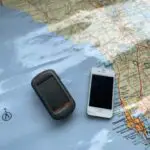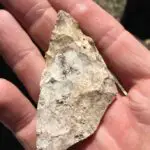Geocaching is an outdoor hobby that sets its devotees out to explore by using GPS or cell phones to look for coordinates, find a nearby “cache,” and log their arrival.
t’s a fun way to discover new places, but like any new activity, people want to know about the risks…
Table of Contents

Is Geocaching Safe?
Geocaching is a safe outdoor hobby enjoyed by millions of people around the world. Most geocaching excursions will consist of a bit of hiking, with the discovery of a cache at the end. The keys to staying safe are to know your limits, be prepared, and pay attention to your surroundings.
There are hundreds of thousands of caches in the United States alone, so there’s a decent chance that there’s one a short drive from where you live — maybe even just around the corner.
Like all outdoor adventures, it’s important to know the risks or potential hazards. But don’t worry, the great thing about geocaching is that you can participate at a level you are comfortable with.
What Are the Risks in Geocaching?
The risks are very similar to those you would have any time you go hiking or walking in an unfamiliar area. The only additional concern — and it usually isn’t a major problem — is the challenge of locating the cache as you approach your target coordinates.
Onlookers — known as “muggles” to geocachers — might not understand what you’re doing. Private property owners or local business owners might be suspicious of people wandering around looking for something.
And while you’re checking your location on your device, or searching for the cache, you may not notice what’s going on around you.
But aside from that, there’s nothing inherently dangerous about geocaching. If you plan ahead and stay alert to your surroundings, you should be just fine and its a ton of fun!
But now, let’s back up just a bit for those who may not completely understand what geocaching is.
What Is Geocaching?
The basic idea behind geocaching is pretty simple and is reminiscent of a treasure hunt. You set out with a very precise set of latitude and longitude coordinates. Using a Global Positioning Satellite (GPS) device or a cell phone app with a tracking system, you work your way to those coordinates and discover a hidden cache left by a fellow geocacher.
When you find the spot, there will be a cache. Usually, this will be a sturdy and waterproof container, like a Tupperware bowl or an old ammunition box.
Sometimes they’re hidden, but most of the time they’re out in the open and not too hard to find.
The cache will have a logbook and most likely some trinkets, known as “swag.” These are usually small, inexpensive items, like toys or unusual coins, or local trinkets.
You enter your username and date in the logbook. If you like, you can exchange a piece of swag with something you brought with you. Then you reseal the cache and put it back where you found it.
That’s it! The joy is in the hunt, and discovery of a hidden cache. It could be hidden in a stump, behind a building, in a tree, or even disguised in plain sight!
Some caches are virtual: You might find a camera that you can use to take a picture of yourself. Or you might need to take a picture and send it to a website or email address to prove you made it to your destination.
Some caches are harder to get to than others. There are geocaches on all seven continents — even one in Antarctica!
Caches can be found in the wild and in big cities. Depending on the terrain, you may have to climb, explore, or boat to get to the cache. But most caches can be reached by anyone who is in good physical condition.
The fun comes from going to out-of-the-way places, seeing new sights along the way, and being a bit of an explorer, leaving and picking up souvenirs as you go.
However, as with all things, safety should always be your number one priority.
Let’s look at a few tips for making your geocaching trips as safe as possible.
Tips for Safe Geocaching
The best plan is to treat geocaching like a day hike. That means doing a little research on the terrain before you leave.
Know Where You Are Going
Most geocache entries will rate the difficulty of getting to the cache on a five-point system: The lower the rating the easier it’ll be to reach your goal. Even if you’re an experienced hiker, you should probably start with a one or a two, just to get a feel for how the process works.
If your cache is in an urban area, you might want to confirm that it’s in a reasonably safe neighborhood, though geocachers won’t go out of their way to leave caches in extremely dangerous locations.
If your cache is out in the countryside, get a sense of what the region is like. In particular, is it flat or hilly? Are you likely to need to do any climbing to get to your destination?
Be honest with yourself about your physical conditioning and agility. Geocaching isn’t as much fun when you can’t make it to the cache, or if you wear yourself out on the way back.
Pick a target that you’re confident you can reach.
Especially for caches in wilderness areas, get a good understanding of the wildlife you’re likely to encounter — and what to do around them.
What To Take With You
Footwear is critical. Open-toed shoes and heels don’t work well for long walks. Good tennis shoes or running shoes will work for urban treks on paved roads or sidewalks.
See Also: Are Basketball Shoes Good For Hiking?
If you picked a cache in the countryside, there’s no substitute for a good pair of hiking boots with rubber soles and good ankle support.
Make sure you have what you need to get out and back. Bring food for a long hike, extra water if the weather is hot, and rain gear if there’s a risk of heavy rain.
If you have adventurous friends you might want to invite one or two of them along with you. That way you can share the burdens, help each other out through the tricky parts, and you have more than one set of eyes on the trail with you.
And in the worst-case scenario, someone can administer first aid or go get help (although unlikely).
The US Park Service has plenty of good tips on how to make your hike safe and enjoyable that you can easily apply to geocaching.
Be sure and take along something to trade for swag. Small toys like action figures or model cars work well, and card games are popular, as well. But don’t use food as swag; food can spoil or become contaminated and stink up a hidden cache.
My favorite things to put into a geocache are old coins, such as wheat pennies or buffalo nickels.
Out on the Trail
Don’t focus too much on your GPS or Smartphone when you’re tracking down your coordinates. Keep an eye out for wildlife in the country or traffic if you’re in the city. Be aware of your surroundings.
Don’t focus on your screen so much that you absent-mindedly walk into traffic or bump into a bear!
When you reach your coordinates, take a minute and look around for anything that might be dangerous before you start looking for the cache.
Especially if you’re out in the wild, keep track of time and make sure you can get back to civilization before dark. Don’t be too proud to break off your trek if you encounter dangerous conditions.
Final Thoughts
Geocaching is not dangerous. It’s very safe, and low cost (it’s virtually free unless you get the paid version). You can participate in a geocache any time you want, with whomever you want, for however long you want.
It’s truly an inclusive hobby that encourages a sense of exploration, good exercise and enjoying the outdoors.
Give it a try and have some fun! Thanks for reading.






